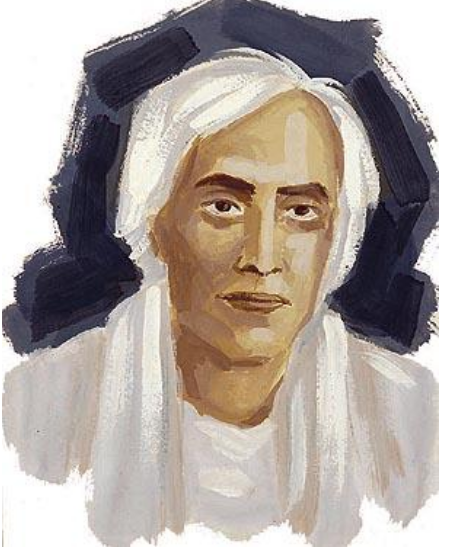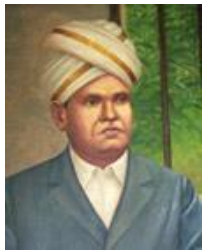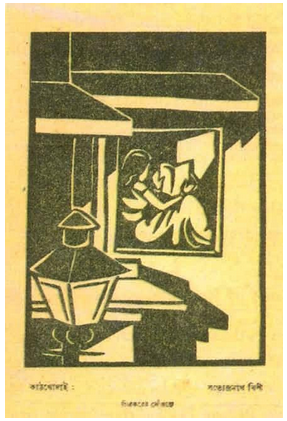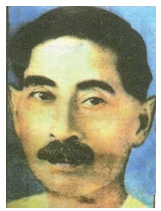Novels In The Colonial World
Novel, Society And History of Class 10
Novels In The Colonial World
- If we follow the history of the novel in different parts of India we can see many regional peculiarities. But there were also recurring patterns and common concerns.

Sarat Chandra Chattopadhyaya
USES OF THE NOVEL:
(i) Colonial administrators found `vernacular' novels a valuable source of information on native life and customs. Such information was useful for them in governing Indian society, with its large variety of communities and castes. The new novels in Indian languages often had descriptions of domestic life. Some of these books were translated into English, often by British administrators or Christian missionaries.
(ii) Indians for e.g Viresalingam, used the novel as a powerful medium to criticise what they considered defects in their society and to suggest remedies.
(iii) Novels also helped in establishing a relationship with the past. Through glorified accounts of the past, these novels helped in creating a sense of national pride among their readers. Novels also helped in creating a sense of collective belonging on the basis of one's language.
(iv) With the coming of novels, language variations entered the world of print for the first time. The way characters spoke in a novel began to indicate their region, class or caste. Thus novels made their readers familiar with the ways in which people in other parts of their land spoke their language.
THE PROBLEM OF BEING MODERN:
Although they were about imaginary stories, novels often spoke to their readers about the real world. But novels did not always show things exactly as they were in reality. Sometimes, they presented a vision of how things ought to be. Social novelists often created heroes and heroines with ideal qualities, who their readers could admire and imitate. How were these ideal qualities defined? In many novels written during the colonial period, the ideal person successfully deals with one of the central dilemmas faced by colonial subjects: how to be modern without rejecting tradition, how to accept ideas coming from the West without losing one’s identity.
Chandu Menon portrayed Indulekha as a woman of breathtaking beauty, high intellectual abilities, artistic talent, and with an education in English and Sanskrit. Madhavan, the hero of the novel, was also presented in ideal colours. He was a member of the newly English-educated class of Nayars from the University of Madras. He was also a ‘first-rate Sanskrit scholar’. He dressed in Western clothes. But, at the same time, he kept a long tuft of hair, according to the Nayar custom.

The heroes and heroines in most of the novels were people who lived in the modern world. Thus they were different from the ideal or mythological characters of the earlier poetic literature of India. Under colonial rule, many of the English-educated class found new Western ways of living and thinking attractive. But they also feared that a wholesale adoption of Western values would destroy their traditional ways of living. Characters like Indulekha and Madhavan showed readers how Indian and foreign lifestyles could be brought together in an ideal combination.
PLEASURES OF READING:
- The circulation of printed books allowed people to amuse themselves in new ways.
- Picture books, translations from other languages, popular songs sometimes composed on contemporary events, stories in newspapers and magazines – all these offered new forms of entertainment.
- In Tamil, for example, there was a flood of popular novels in the early decades of the twentieth century.
- Detective and mystery novels often had to be printed again to meet the demand of readers: some of them were reprinted as many as twenty-two times.
- As late as the nineteenth century and perhaps even in the early twentieth century, written texts were often read aloud for several people to hear.
- Sometimes novels were also read in this way, but in general novels encouraged reading alone and in silence.
- Individuals sitting at home or travelling in trains enjoyed them.
- Even in a crowded room, the novel offered a special world of imagination into which the reader could slip, and be all alone. In this, reading a novel was like daydreaming.
WOMEN AND THE NOVEL:
(i) Many people got worried about the effects of the novel on readers who were taken away from their real surroundings into an imaginary world where anything could happen. They advised people to stay away from the immoral influence of novels. Some parents kept novels in the lofts in their houses, out of their children's reach. Young people often read them in secret.
(ii) Women did not remain mere readers of stories written by men, soon they also began to write novels. In some languages, the early creations of women werenoems, essays or autobiographical pieces. In the early decades of the twentieth century, women in south India also began writing novels and short stories. A reason for the popularity of novels among women was that it allowed for a new conception of womanhood. Stories of love - which was a staple theme of many novels - showed women who could choose or refuse their partners and relationships. Some women authors also wrote about women who changed the world of both men and women.

A woman reading reading. Woodcut by Satyendranath Bishi
(iii) Rokeya Hossein (1880-1932), a reformer wrote a satiric fantasy in English called Sultana's Dream (1905) which shows a topsy-turvy world in which women take the place of men. Her novel also showed the need for women to reform their condition by their own actions.
(iv) It is not surprising that many men were unsuspicious of women writing novels or reading them. This suspicion cut across communities Hannah Mullens, a Christian missionary and the author of Karuna o Phulmonir Bibaran (1852), reputedly the first novel in Bengali, tells her readers that she wrote in secret. In the twentieth century, Sailabala Ghosh Jaya, a popular novelist, could only write because her husband protected her.
CASTE PRACTICES, ‘LOWER-CASTES’ AND MINORITIES
Case of Indulekha: Indulekha was a love story. But it was also about an issue that was hotly debated at the time when the novel was written. This concerned the marriage practices of upper-caste Hindus in Kerala, especially the Nambuthiri Brahmins and the Nayars. Nambuthiris were also major landlords in Kerala at that time; and a large section of the Nayars were their tenants. In late-nineteenth century Kerala, a younger generation of English-educated Nayar men who had acquired property and wealth on their own, began arguing strongly against Nambuthiri alliances with Nayar women. They wanted new laws regarding marriage and property. The story of Indulekha is interesting in the light of these debates. Suri Nambuthiri, the foolish landlord who comes to marry Indulekha, is the focus of much satire in the novel. The intelligent heroine rejects him and chooses Madhavan, the educated and handsome Nayar as her husband, and the young couple move to Madras, where Madhavan joins the civil service. Suri Nambuthiri, desperate to find a partner for himself, finally marries a poorer relation from the same family and goes away pretending that he has married Indulekha! Chandu Menon clearly wanted his readers to appreciate the new values of his hero and heroine and criticise the ignorance and immorality of Suri Nambuthiri.
STORY OF SARASWATIVIJAYAM:
- Potheri Kunjambu, a ‘lower-caste’ writer from north Kerala, wrote a novel called Saraswativijayam in 1892, mounting a strong attack on caste oppression.
- This novel shows a young man from an ‘untouchable’ caste, leaving his village to escape the cruelty of his Brahmin landlord.
- He converts to Christianity, obtains modern education, and returns as the judge in the local court.
- Meanwhile, the villagers, thinking that the landlord’s men had killed him, file a case.
- At the conclusion of the trial, the judge reveals his true identity, and the Nambuthiri repents and reforms his ways. Saraswativijayam stresses the importance of education for the upliftment of the lower castes.
- From the 1920s, in Bengal too a new kind of novel emerged that depicted the lives of peasants and ‘low’ castes.
STORY OF TITASH EKTI NADIR NAAM:
- Advaita Malla Burman’s (1914-51) Titash Ekti Nadir Naam (1956) is an epic about the Mallas, a community of fisherfolk who live off fishing in the river Titash.
- The novel is about three generations of the Mallas, about their recurring tragedies and the story of Ananta, a child born of parents who were tragically separated after their wedding night. Ananta leaves the community to get educated in the city.
- The novel describes the community life of the Mallas in great detail, their Holi and Kali Puja festivals, boat races, bhatiali songs, their relationships of friendship and animosity with the peasants and the oppression of the upper castes.
- Slowly the community breaks up and the Mallas start fighting amongst themselves as new cultural influences from the city start penetrating their lives.
- The life of the community and that of the river is intimately tied. Their end comes together: as the river dries up, the community dies too.
- While novelists before Burman had featured ‘low’ castes as their protagonists, Titash is special because the author is himself from a ‘low-caste’, fisherfolk community.
STORY OF VAIKKOM MUHAMMAD BASHEER:
- Vaikkom Muhammad Basheer (1908-94), for example, was one of the early Muslim writers to gain wide renown as a novelist in Malayalam.
- Basheer had little formal education. Most of his works were based on his own rich personal experience rather than on books from the past.
- When he was in class five at school, Basheer left home to take part in the Salt Satyagraha.
- Latter he spent years wandering in different parts of India and travelling even to Arbia, working in a ship, living with Sufis and Hindu sanyasis, and training as a wrestler.
- Basheer’s short novels and stories were written in the ordinary language of conversation.
- With wonderful humour, Basheer’s novels spoke about details from the everday life of Muslim households.
- He also brought into Malayalam writing themes which were considered very unusual at that time – poverty, insanity and life in prisons.
THE NATION AND ITS HISTORY:
(i) The history written by colonial historians tended to depict Indians as weak, divided, and dependent on the British. People educated and working under the English system wanted a new view of the past that would show that Indians could be independent minded and had been so in history. For these people novel provided a solution. In it, the nations could be imagined in a past that also featured historical characters, places, events and dates.
(ii) In Bengal, many historical novels were about Marathas and Rajputs. These people produced a sense of a pan-Indian belonging. They imagined the nation to be full of adventure, heroism, romance and sacrifice - qualities that could not be found in the offices and streets of the nineteenth-century world. Bhudeb mukhopadhyay's (1827-94) Anguriya Binimoy (1857) was the first historical novel written in Bengal. Its hero Shivaji gets the courage and tenacity from his belief that he is a nationalist, fighting for the freedom of Hindus.
(iii) The imagined nation of the novel was so powerful that it could inspire actual political movements. Bankim's Anandmath (1882) was a novel that inspired many kinds of freedom fighters.
(iv) Many of these novels also reveal the problems of thinking about the nation.
THE NOVEL AND NATION MAKING:
Imagining a heroic past was one way in which the novel helped in popularising the sense of belonging to a common nation. Another way was to include various classes in the novel so that they could be seen to belong to a shared world.
Premchand's novels are filled with all kinds of powerful characters drawn from all levels of society. Unlike many of his contemporaries, Premchand rejected the nostalgic obsession with ancient history. Instead, his novels look towards the future without forgetting the importance of the past. Drawn from various strata of society, Premchand's characters create a community based on democratic values. The central character of his novel Rangbhoomi (The Arena), Surdas, is a visually impaired beggar from a so-called `untouchable' caste. The very act of choosing such a person as the 'hero' of a novel is significant. As we read the story we wonder about industrialisation and its impact on society and people. The story of Surdas was inspired by Gandhiji's personality and ideas.
Godan (The Gift of Cow), published in 1936, remains Premchand's best-known work. It is an epic of the Indian peasantry. The novel tells the moving story of Hori and his wife Dhania, a peasant couple and the problems faced by them in retaining their dignity.

Portrait of Premchand (1880-1936)
|
Author |
Novel |
Theme |
|
|
1. |
Devkinandan Khatri |
Chandrakanta |
Romance and Fantasy. |
|
2. |
Chandu Menon |
Indulekha |
Love story, Nambudri alliance with Nayar women. |
|
3. |
Shrinivas Das |
Pariksha Guru |
Dangerous influence of bad company. |
|
4. |
Prem Chand |
Sewasadan, Rangbhoomi, Godan |
Life of ordinary people in the society. Story of untouchable caste. Epic of Indian peasantry. |
|
5. |
Bankimchandra |
Durgeshnandini, Anandmath |
Urban life. Secret Hindu militia fighting against Muslim to establish a Hindu kingdom. |
|
6. |
Rokeya Hossein |
Sultan’s Dream, Pandma Rag |
World in which women take the place of men. Need for women to reform their condition. |
|
7. |
Bhudeb Mukhopadhya |
Anguria Binimoy |
First historical novel in Bengal |
|
8. |
Potheri Kunjambu |
Saraswati Vijayam |
Strong attack on caste oppression. |
|
9. |
Advaita Malla Burmans |
Titash Ekti Nadir Naam |
Epic about mallas who lives off fishing in the river Titash. |
|
Author |
Novel |
Theme |
|
|
1. |
Samuel Richardson |
Pamela |
Story through an exchange of letters between two lovers. |
|
2. |
Henry Fielding |
Tom Jones |
|
|
3. |
Charles Dickens |
Pickwick Papers |
First book to be serialized in magazines. |
|
Hard Times |
Effect of Industrialization on people's lives. |
||
|
Oliver Twist |
How a poor orphan lived in world of petty criminals. |
||
|
4. |
Emil Zola |
Germinal |
Young miner in France explores the grim conditions of miner’s lives. |
|
5. |
Thomas Hardy |
Mayor of casterbridge |
The loss of the more personalized world that was disappearing. He wrote about tradition rural community life. |
|
6. |
Jane Austen |
Pride and Prejudice |
Good marriages and how to find wealthy husbands. |
|
7. |
Charlotte Bronte |
Jane Eyre |
Independent and assertive women. Protest against the hypocrisy. |
|
8. |
R.L. Stevenson |
Treasure Island |
Heroic and honorable colonizer colonizing territory of inferior race. |
|
9. |
Rudyard Kipling |
Jungle book |
Glorifying European culture and justifying colonization. |
|
10. |
Helen Hunt Jackson |
Ramona |
Love story of an adolescent girl. |
|
11. |
Sarah Chauncey Woolsey |
What Katy did |
Love story |
|
12. |
Daniel Defoe |
Robinson Crusoe |
Adventure of sea voyage superiority of white over coloured people. |
(i) Stories in prose were not new to India. Banabhatta's Kadambari and Vishnudatta's Panchatantra are good examples. There was also a long tradition of prose tales of adventure and heroism in Persian and Urdu, known as Dastan.
(ii) The modern novel form developed in India in the nineteenth century. The development of the vernaculars, print and a reading public helped in this process. Some of the earliest Indian novels were written in Bengali and Marathi. The earliest novel in Marathi was Baba Padmanji's Yamuna Paryatan (1857), was followed by Lakshman Moreshwar Halbe's Muktamala (1861).
(iii) Leading novelist of the nineteenth century wrote for a cause. Indian novelist wrote to develop a modern literature of the country that could produce a sense of national belonging and cultural equality with their colonial masters.
(iv) Translations of novels into different regional languages helped to spread the popularity of the novel and stimulated the growth of the novel in new areas.
THE NOVEL IN SOUTH INDIA:
- O. Chandu Menon, a subjudge from Malabar, tried to translate an English novel called Henrietta Temple written by Benjamin Disraeli into Malayalam.
- But he quickly realized that his readers in Kerala were not familiar with the way in which the characters in English novels lives: their clothes, ways of speaking, and manners were unknown to them.
- His delightful novel called Indulekha, published in 1889, was the first modern novel in Malayalam.
- The case of Andhra Pradesh was strikingly similar. Kandukuri, Veeresalingam (1848-1919) began translating Oliver Goldsmith’s Vicar of Wakefield into Telugu.
THE NOVEL IN HINDI:
Early Hindi novels were actually translated and adapted from English and Bengali under the influence of Bhartendu Harishchandra, the pioneer of modern Hindi literature.
(i) The first proper modern novel was written by Srinivas Das of Delhi, Srinivas Das' novel, published in 18821: was titled Pariksha-Guru. The characters in the novel are caught in the difficulty of adapting to colonised society and at the same time preserving their own cultural identity. The novel tries to teach the reader to remain rooted in the values of their own tradition and culture, and to live with dignity and honour. In the novel the characters take to new agricultural technology, modernise trading practices, change the use of Indian languages, transmitting both western sciences and Indian wisdom. The young are urged to cultivate the healthy habit of reading the newspapers. But the novel emphasises that all this must be achieved without sacrificing the traditional values of the middle-class household. With all its good intentions, Pariksha Guru could not win many readers.
(ii) Devaki Nandan Khatri’s chandrakanta is believed to have contributed immensely in popularising the Hindi language and the nagari script among the educated classes of those times.
(iii) It was with the writing of Premachand that the Hindi novel achieved excellence. He drew on the traditional art of Kissa−goi (storytelling) many critics think that his novel Sevasadan published in 1916, lifted the hindi novel from the realm of fantasy, moralising and simple entertainment to a serious reflection on the lives of ordinary people and social issues. Sevasadan deals mainly with the poor condition of women in society. Issues like child marriage and dowry are woven into the story of the novel.
Novels in Bengal
In the nineteenth century, the early Bengali novels lived in two worlds. Many of these novels were located in the past, their characters, events Write about two important characteristics of the early Hindi novel. One group was about historical characters and love stories based on historical events. Another group of novels depicted the inner world of domestic life in contemporary settings. Domestic novels frequently dealt with the social problems and romantic relationships between men and women.
The old merchant elite of Calcutta patronised public forms of entertainment such as kabirlarai (poetry contests), musical soirees and dance performances. In contrast, the new bhadralok found himself at home in the more private world of reading novels. Novels were read individually. They could also be read in select groups. Sometimes the household of the great Bangla novelist Bankim Chandra Chattopadhyay would host a jatra in the courtyard where members of the family would be gathered. In Bankim’s room, however, a group of literary friends would collect to read, discuss and judge literary works. Bankim read out Durgeshnandini (1865), his first novel, to such a gathering of people who were stunned to realise that the Bengali novel had achieved excellence so quickly.
Besides the ingenious twists and turns of the plot and the suspense, the novel was also relished for its language. The prose style became a new object of enjoyment. Initially the Bengali novel used a colloquial style associated with urban life. It also used meyeli, the language associated with women’s speech. This style was quickly replaced by Bankim’s prose which was Sanskritised but also contained a more vernacular style.
THE MESSAGE OF REFORM:
Many early novels carried a clear message of social reform. For example, in Indirabai, a Kannada novel written by Gulavadi Venkata Rao in 1899, the heroine is given away in marriage at a very young age to an elderly man. Her husband dies soon after, and she is forced to lead the life of a widow. In spite of opposition from her family and society, Indirabai succeeds in continuing her education. Eventually she marries again, this time a progressive, English educated man. Women’s education, the plight of widows, and problems created by the early marriage of girls – all these were important issues for social reformers in Karnataka at that time.









